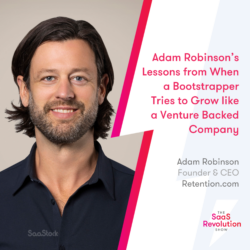This is a guest post from Dan Wheatley – CEO and co-founder of StraightTalk Consulting, a SAAS operations and growth consultancy which works with B2B founders to implement long term data-driven growth strategies.
While the current lockdown has hit businesses of all shapes and sizes, early-stage SaaS startups are particularly feeling the pressure as enterprise consumers adopt ‘shelter in place’ strategies to weather out the storm. In an attempt to stay out of the red, many early-stage founders will inevitably panic and forgo the crucial processes they need to optimize their startup before achieving growth, instead of seeking profits wherever they can find them.
But, while Seeking Alpha reports that SaaS companies will see slower revenue growth in early 2020, it also predicts that the market will recover fast once businesses return to action. If you want to survive – and be ready to hit the ground running once conditions allow for it – you need to use this downtime to look inwards and maximize all your business processes. Yes, it sounds like a long-term strategy, but it will improve your short-term success too.
Here’s how early-stage SaaS founders can prepare their startup for growth during the new normal by making sure their internal processes are running as smoothly as possible, lockdown or not.
You need a bird’s eye view: getting your data in order
First things first: you need a full visual of how your startup is operating before you can bring it up to full potential. If you are not reporting and processing all your vital metrics already, there’s no time like the present. You need to establish your success metric – the best indicator that your product is being used successfully – and other meaningful data like active users, user engagement, and funnel conversion rate.
These aren’t as self-explanatory as they seem, so don’t settle for superficial data that doesn’t give you a real picture of what your clients and your business are doing. For example, the number of people who download your app is not the same as your active user number. Ask yourself if you know how many of those users opened the app more than once, how many bought a subscription, or the frequency with which they use it. Boil down each indicator to its practical meaning.
At our consultancy, we’ve too often asked startups basic questions like: How many people make it through your onboarding (vs how many people start the process)? How many people achieve your success metric (have you defined one)? and been met with blank stares. Without this basic data, you’re going in blind to any business strategy you decide to implement.
Other startups won’t be looking internally right now, as they’ll be preoccupied with what’s changing in the conditions around them. But not knowing your business inside out will give it a short life expectancy.
Your internal process: setting up your CRM
Once you’ve got a solid grasp on your data, you’ll want to assess how your business is running day-to-day and how it aims to achieve steady growth. There is no silver bullet to growth – it will come once all the different parts of your business are working together in harmony. This is what you need to focus your time on now; if you leave it too late (or try too early to expand exponentially) your company won’t be ready for growth once the conditions are right.
At the heart of this is your customer relationship management (CRM) system. All your core processes should be centered around the CRM, and all your data sources should feed into it (the essential data explained in step one should all be available to examine and process within your CRM).
Which means choosing the right CRM platform can make or break you. If you haven’t yet found an ideal tool stack, the first rule (and this applies to all your software choices) is to build the stack you need now. You’ll trip yourself up if you try to build something that will serve your business in five years’ time, when your entire company will have changed and expanded. You’d probably also spend far too much money for your current position. So don’t overinvest on the “best” software, but go for value for money – the most important thing is to dedicate enough time and resources to ensure that the system can execute (and automate) all the processes your business needs today. If you have to rebuild a new one in a year, so be it.
One of our favorite tool stacks for outbound lead generation, for example, is Outreach. It’s one of the leading products in the market right now, and it’s worth its price. Autopilot is a highly integrated marketing automation tool, and LeadIQ is a great choice for sales prospecting.
Finding the best tool stack is completely different for all businesses, and it may be a process of trial and elimination.
Maximizing your internal processes
Too many startups struggle with implementing their tool stacks. This is why data is so essential – you need it to identify exactly which areas of your business need to be made more efficient. Be prepared for a long process of trial and error.
First, if your CRM isn’t your company’s single source of truth, you need to make it so. Think of it as the hub of a wheel, with each separate spoke representing a branch of your business. All of the spokes feed into the hub and rely on the hub’s combined data and automated processes. Start directing your essential data to your CRM – the leads from your website, Facebook ad data, etc.
Once your CRM is properly integrated across your business, use it to maximize each part of your company. This is a highly repetitive process. You’ll have to identify exactly what each sector of your business needs to improve, make a tailored plan to achieve this goal, execute it, hit roadblocks, and adjust. Your final plan might look nothing like the first, but it will ensure you have a smooth end-to-end system. The better the cogs are working, the more you’ll be able to generate successful leads and sales, and retain customers.
Now more than ever, you’ll find that maximizing your business means offering potential clients real solutions to their problems. This should always be a core concept in any of your strategies. Here’s an example of how we’ve integrated that idea into our CRM.
To make sure we can address the problems our potential clients need solving before they move too far down the sales pipeline, we have implemented mandatory fields for every deal stage – fields that have to be met before the sales representative can advance with a customer. This is usually a standard feature in CRM tools. So for example, if my business offers two services – sales consulting and marketing consulting – the sales rep would not be able to move the potential client from lead to qualified lead until they know which of our offerings they’re interested in. This ensures standardization of quality.
Testing is another crucial element to refining your internal processes. A CRM has to have an organized log of all your contacts, but not only that. You can carry out automated tests on your mailing lists to end up with the best outreach strategy. This works well with potential leads. If you have a number of leads generated via Facebook ads, separate them into different lists to carry out split testing. That will allow you to see what types of emails receive the best responses. Then you can separate the leads based on their behavior: those who respond positively can pass on to a nurturing list, and the others can stay on the testing list. That entire process can be automated, tracked and analyzed using the right tool.
Again, mastering automation means integrating all the different elements and tools of your lead generation, marketing, and sales processes together. It also means getting staff 100% on board. Your team will make sure the system keeps running once it’s off the ground, so make sure they’re involved in every step of setting it up so that they are familiar with, and trust, the mechanics of it all.
The lockdown may feel like the worst time to be focusing on such detailed processes, but doing it now will give you the time to test, continually analyze data, and ready your business machine for future growth. So if you feel like you’re taking two steps back to take one step forward, that may be the case, but it’s better than making the classic (often fatal) startup mistake of trying to run before you can walk.
Outbound lead generation
The final element of your business that you can maximize today is your outbound lead generation.
Outbound lead generation might not be the best option for all startups right now, but if you have enough runway and decide to go for it, you should commit to a long-term spend – probably at least 12 months. This is because it often takes around a year to see the full results of an outbound lead generation strategy – from acquiring a lead to turning it into a paying user.
The problem with a lot of startups is that they don’t look far ahead enough. They start an outbound strategy, hire expensive external contractors to carry it out, and have to abandon it too early because they didn’t plan their expenses for more than a few months.
Before launching into outbound lead generation, first understand your timeframe by taking these steps. Assess your product-market fit – are you unique (i.e. will it take you a short amount of time to generate many potential leads) or do you have many competitors (i.e. will it take you longer to build a narrative that will make you stand out to potential clients)? Assess the deal sizes are you looking to land (smaller deal sizes tend to generate a greater volume of interest).
Finally, add the length of your sales cycle on top of the amount of time it will take to generate a qualified lead. A general rule of thumb is that it takes around one month per $10,000 in deal size. All things considered, it’ll probably be a year before you know how well your outbound strategy has worked, so stopping half way will lose you money and also give you little feedback on best engagement tactics.
Improving the success rate of your outbound lead generation will be a long process of trial and error, and it will require you to test constantly.
Strategies you could use to find the best outreach strategies include split testing (for example sending out the same email using different email subjects for different lists). You can also experiment with personalized vs automated outreach. Try out different forms of personalized outreach, especially during your first contact with a potential lead. You should also test out different platforms, from emails to social media and LinkedIn.
As you continue to test, the metrics you’re going to want to hit will vary depending on the business. But these are some ideal target results:
- Top Line Reply Rate: ≥ 12%
- Email Open Rate: ≥ 27%
- Email Reply Rate: ≥ 2.9%
- Bounce Rate: ≤ 2.8%
- Opt Out Rate: ≤ 1.1%
Don’t reach for certain metrics without considering the steps you need to get you there. You’ll be most interested in improving your top line reply rate, but that will be hindered if the other metrics are behind (e.g. you have a low email open rate), so focus on improving these first by testing different approaches.
If you try to scale your customer acquisition without a well-oiled customer acquisition, CRM and data processing system, you won’t be able to cope with increasing volumes of customers. Use this unprecedented time to do what so many startups fail to take seriously, and you’ll be at an advantage both in the short and long term.





